[EDIT: you can read the stories from my progress across my map here.]
I filled my bottles with ice before heading out this morning. It is the hottest day of the year, dry and still as I pedal. Meanwhile in Germany and China are flooding and people are dying. The climate is changing, rapidly and unpredictably.
The main feature I am expecting on today’s grid square are polytunnels. Row after row of white plastic tunnels filled with raspberry plants. There are so many that you see them easily from a plane when circling over London waiting to land. Hundreds of square metres of plastic farming. Not beautiful, like traditional farmland appears at a glance, but undoubtedly more efficient. And this, perhaps, is the future of farming that we need. The polytunnel’s main use is to create a sort of microclimate that provides higher temperatures and humidity allowing you to grow various fruit and vegetable plants even when they are out of season. They are also an excellent form of crop protection, protecting plants from heat, cold, wind, rain and strong sunlight.

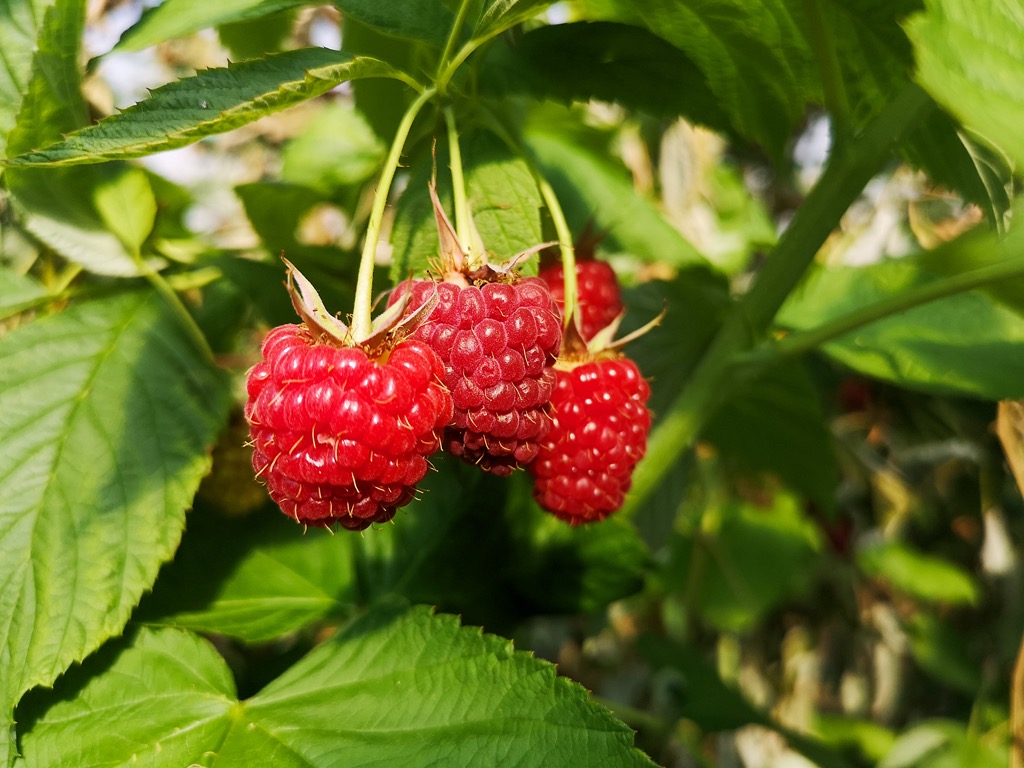
These Greenhouses are generally more sustainable than ‘normal’ agriculture as they use fewer pesticides, less water and less fertilizers. Moreover, they have a higher return per unit area than crops that are grown in the open field, and are able to produce food throughout the whole year.
But there are some sustainability issues here. The Dutch are often celebrated for their modern farming techniques. But Dutch emissions of ammonia, the surpluses of nitrogen and phosphorus, and the use of pesticides per hectare of agricultural land are among the highest in the European Union. Despite all the successful European policies and farm measures to reduce the massive pollution, environmental pressure caused by agriculture is still the biggest threat to biodiversity in Europe and in the Netherlands.
Although Greenhouse horticulture is very efficient and definitely a solution- as mister Attenborough described- to ‘feed many with less’. Dutch agriculture, including horticulture, also contributes 14% (32 Mton CO2-eq in 2016) to their national emissions of greenhouse gasses (GHG). And the thing is: they have hardly decreased since 2000. Indeed, greenhouses are a very energy extensive sector in the Netherlands and take up almost 80% of all energy that is used for agriculture. Greenhouses still use mainly fossil fuels for lighting, heating and fertilizers. Moreover, these large concentrations of greenhouses generate huge quantities of waste that need to be disposed of (which costs a lot of energy as well).
Many companies in the greenhouse sector are already taking steps towards using renewable energy. For example, renewable energy types such as geothermal heating or heat exchangers. However, we will not be able to feed the entire world with greenhouses and vertical indoor farming only. Not all crops are able to grow in these pre-made circumstances and this type of horticulture worldwide requires too much energy (even with renewable energy), environmental damage and money to build. Money that many places in the world do not have the luxury of having.
We should probably not place our entire trust in technologies to save us from the agricultural problems we are facing, but also assess how we can make our land usage more sustainable and promote more environmental friendly farming everywhere. It is our eating habits and our food policies and values that need changing.
I enjoyed the fact that the footpath ran straight down the middle of one of these long tunnels. It was ferociously hot in there and I sustained myself by foraging (aka ‘stealing’) a few raspberries. I felt a little guilty, but I was also a bit disturbed to see upfront just how much fruit was wasted and rotting on the plants. Estimates predict that 3.6 million tonnes, or 7.2% of all food harvested, is wasted before it leaves UK farms every year. If this wasted food had been sold at market value, it would have fetched £1.2 billion. Supermarkets unfairly prioritise availability and consistency over anything else when dealing with UK farmers. They transfer the responsibility for surplus produce onto our farmers, who are left with little or no options to redistribute the food.
Supermarket contracts can be inflexible, not considering that exact amounts of produce are outside of the farmer’s control. Unpredictable ripening patterns and environmental factors, like weather, pests and diseases, can all affect the final crop. At the same time, supermarkets regularly cancel orders unexpectedly, amend demand forecasts at the last-minute and change pre-agreed supply quantities. They’re often in pursuit of the cheapest offer and respond impulsively to fluctuating consumer demand, rather than honouring the orders they’ve already placed with farmers. Supermarkets have stringent cosmetic standards, meaning crops must be a specific shape, size or colour or they can be rejected before they’ve left the farm gate. Farmers face pressure to meet supermarkets’ orders in full or risk losing contracts. So that they know they’ll have enough ‘acceptable’ food for orders, farmers must produce too much crop.
The heat was rising now and I envied the breeze ruffling a buzzard’s feathers perching atop the pylons of the high speed railway. The roadside wild flowers are past their best now, wilting, look hangdog, dusty and tired. In the distance I saw my first combine harvester of the season, big as a tank and up on the hill. I cling to shade and the last of the morning dew feels cool on my toes as I cycle down a grassy path alongside a crisp, brown field, the wheat seeming to ripen before my eyes. The day already holds a heavy, hot silence. It reminds me of Spain. A voice carries from somewhere across the fields. I’m roasting. And it’s still only 9.30.
This week is Lughnasadh (known as Lammas in England). It marks the halfway point between the summer solstice and the autumn equinox. We still have half of the summer to go, but the harvest begins. Similar to Litha, it is one of the Gaelic seasonal celebrations. We are at the height of warmth and abundance, but at the same time we know that change is coming sooner rather than later.
Lughnasadh is mentioned in some of the earliest Irish literature of pagan origins. In Irish mythology, the festival was begun by the god Lugh as a funeral feast in commemoration of his mother Tailtiu. She was said to have died of exhaustion clearing the plains of Ireland for agriculture. Tailtiu was an earth goddess who represented dying vegetation that fed mankind. The solemn cutting of the first of the corn would be made as an offering to the deity by bringing it to a high place and burying it. It corresponds to similar harvest festivals around the rest of Europe. It was marked with ritual athletic contests, feasting, matchmaking, and trading.
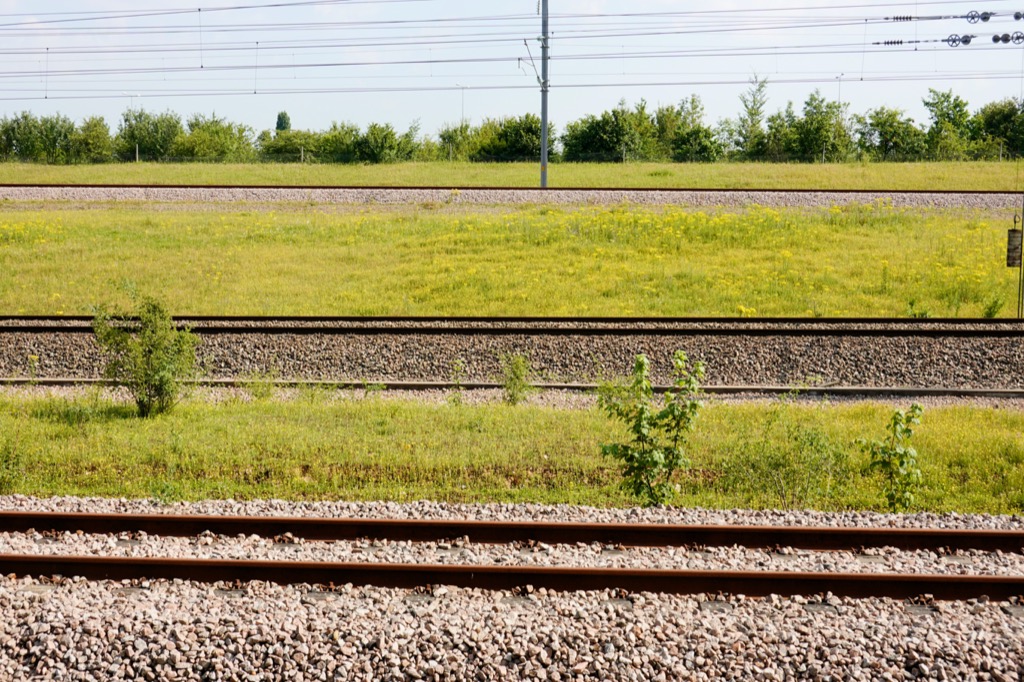

Cherry trees are dotted occasionally around this square, ghostly reminders of earlier land use here. Before the polytunnels and the wheat fields and the redevelopment of farms into ‘exclusive residential developments for the high demands of modern living’ this area was covered in cherry orchards. The ebbs and flows and ups and downs of the land I have been treading this year has been one of its most fascinating features, and far from as depressing as I might have envisaged. This hay field will not be a hay field for ever. That new railway line will one day be old, one day be obsolete, one day not be there at all any longer. I pass a crumbling barn so enmeshed in ivy that its collapse and disintegration into the earth feels only days away. This land is fluid, flexible and fixable. Us humans might be in mighty danger (excluding us rich folk, obviously), but the planet will be fine without us.
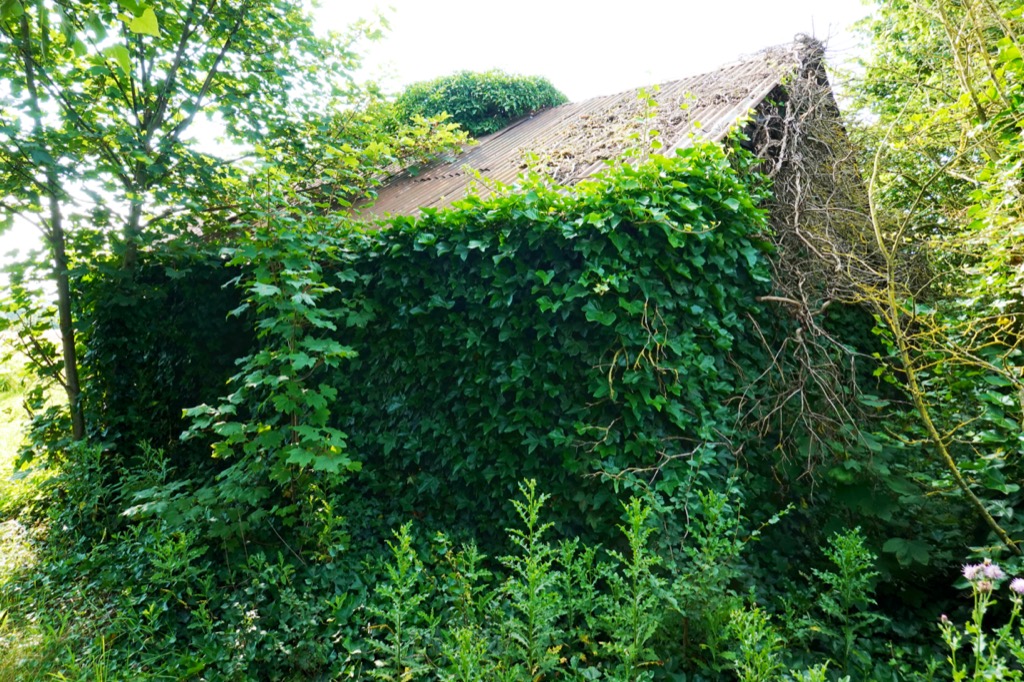
I passed down a narrow footpath through a field of scratchy wheat, then through a softer field of linseed. I don’t remember seeing maize growing on my map before, but there it is looking tropical and lush, its waxy green leaves a darker shade than all the other plants nearby. Corn is one of the world’s most important crops. We don’t just pop it and munch it on the cob; corn can be turned into flour and syrup, it is fed to livestock, it is transformed into ethanol and it can even be used to make plastic. Between 2016 and 2017, about a billion tons of corn were produced around the globe, and corn yields more than six percent of all food calories for humans.


Most scientists agree that maize originated in central Mexico and was domesticated 7-9,000 years ago from a wild grass called teosinte. Teosinte looked nothing like modern maize, in particular due to its having smaller, fewer and more spaced out kernels, each surrounded by a tough casing. While it is descended from Teosinte, modern day corn, with its closely-packed kernels, does not exist in the wild and could not survive without human agricultural intervention.
Early farmers in Mexico domesticated Teosinte by selecting the biggest and best kernels until the crop we recognise today as maize was arrived at. Maize spread fast because it was nutritious, easy to grow, easy to store and easy to carry. Domesticated maize initially spread south down the coast to Peru and beyond, as well as across the North Americas, until eventually Native Americans continent-wide had adopted it as a vital part of their diet. Before long, it was a staple food across most cultures in North and South America and the Caribbean. Although maize has long been a significant crop on the European continent, it only became significant in the UK relatively recently, where it is mainly grown as food for livestock, and as game cover. Additionally, in recent decades the increasing trend for green power has driven farmers to use it as an energy crop for anaerobic digesters. The amount of maize grown in the UK has rocketed since the 1970s. In 1973 there was around 20,000 acres of maize being farmed in Britain, by 2016 this had reached 450,000 acres. And there is no sign of this growth slowing down.
The Columbian exchange, also known as the Columbian interchange, was the widespread transfer of plants, animals, precious metals, culture, human populations, technology, diseases, and ideas between the Americas, the western hemisphere, and the Old World, the eastern hemisphere, in the late 15th and following centuries. It is named after Christopher Columbus and is related to European colonization and trade following his 1492 voyage. Some of the exchanges were purposeful; some were accidental or unintended. Communicable diseases of Old World origin resulted in an 80 to 90 percent reduction in the number of indigenous peoples of the Americas in the 16th century. The cultures of both hemispheres were significantly impacted by the migration of people (both free and enslaved) from the Old World to the New. African slaves and European colonists replaced the indigenous population in some areas. The number of Africans coming to the New World was far greater than the number of Europeans coming to the New World in the first three centuries after Columbus.[1][2]
The new contacts among the global population resulted in the interchange of a wide variety of crops and livestock, which supported increases in food production and population in the Old World. American crops such as maize, potatoes, tomatoes, tobacco, cassava, sweet potatoes, and chilli peppers became important crops around the world. Old World rice, wheat, sugar cane, and livestock, among other crops, became important in the New World. American-produced silver flooded the world and became the standard metal used in coinage, especially in imperial China.
I saw on my map a blob of blue and headed to investigate, hoping (with extreme naivety) that I might find a clear, deep pond I could swim in. No such luck. It was a very disappointing pond, muddy, ringed with officious signs, and the lone lifebuoy hurled by some moron (who I hope cannot swim) out onto the mud. A green sign told me that this pond was, alas, not really a pond but a PCD: a Pollution Control Device. There are various valves, pumps and pounds that can be sealed in an event of an accident to stop chemical spillages going into the environment further. More encouraging was the lane I rode to reach the pond, a lane beside the dual carriageway which was a riot of colour. Amongst the green grass and shrubs and small trees were millions of dots of yellow and white flowers, the yellow Hawkweed Oxtongue and the white Wild Carrot (also known as Queen Anne’s lace), each with a single, tiny red flower at the centre of its head of white florets.

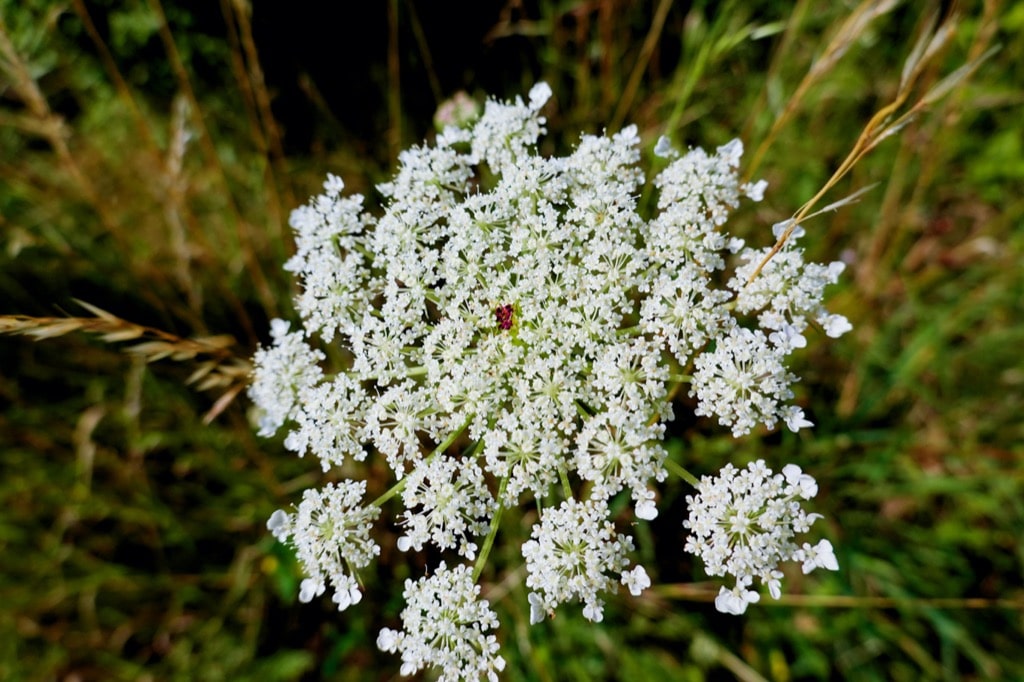
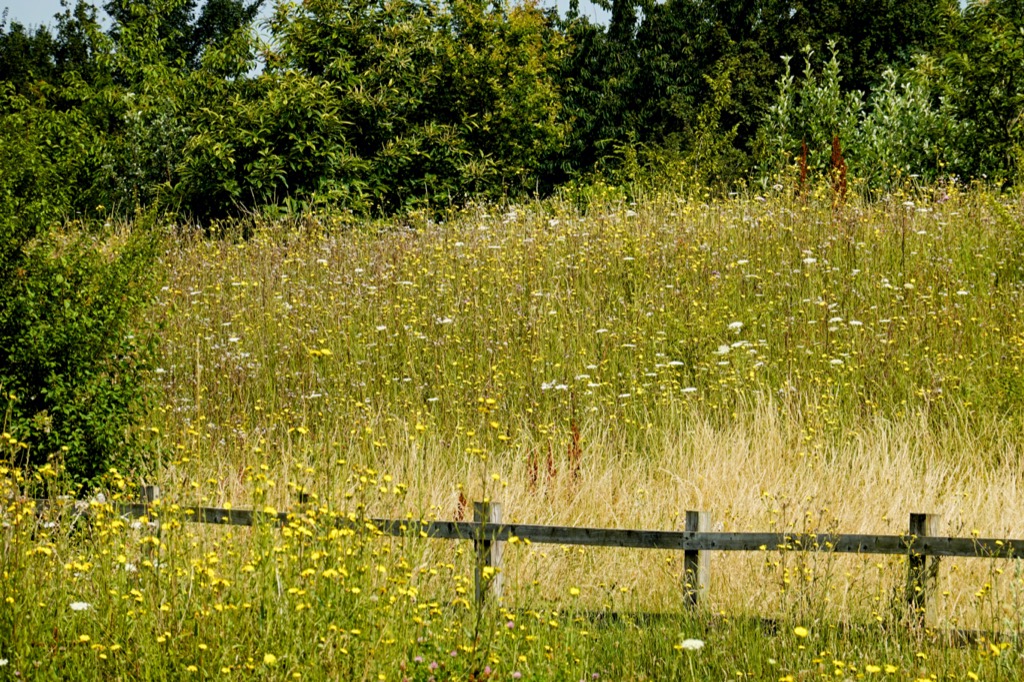
I stopped to listen to the whirring click of grasshoppers amongst the dry grass and wildflowers. There are about 25,000 species of Orthopteroids worldwide. In the UK, there are 11 native species of grasshopper, including the Common field grasshopper, but about 30 species actually live and breed here. The Common field grasshopper can be found in sunny, grassy areas, particularly gardens, throughout summer. Males can be seen rubbing their legs against their wings to create a ‘song’ for the females.
These grasshoppers use their hind legs to produce rhythmic sounds that attract members of the opposite sex, but both males and females produce chirping sounds for different reasons. When a male grasshopper seeks a mate, it will perch itself on a piece of grass in order to broadcast its mating call to the insect community. Researchers have found that these males will produce songs that make use of five to twelve different musical notes. Their songs become more complicated as males compete with one another to produce the most impressive songs. Females will indicate which males they prefer by mimicking their songs.
The jumping and chirping behaviours that grasshoppers are well known for is only possible due to their powerful hind legs. A grasshopper’s hind legs are outfitted with a row of tiny pegs that resemble the teeth on a file. In order to create their chirping sounds, grasshoppers rub their hind legs against their rough wing casings. The chirping sounds can be heard when the pegs on their hind legs effectively rub against the hardened veins that are imprinted on their wing casings. Grasshoppers and crickets began chirring 230 million years ago, filling the air of the Permian moss forests with their cheery sound.
Much of this grid square is the no man’s land beside the railway track and the dual carriageway. These are good corridors for nature as no humans go there. There are so many ‘feels’ to this grid square. I cross the dual carriageway on a bridge then tuck left up a hard-to-spot footpath. This led me up onto a swathe of green haymeadow dotted with blue wildflowers and butterflies. I could still hear traffic, but this green expanse was peaceful and felt surprisingly like countryside. Finding new paths close to home has been one of the points of this whole exercise. I make a mental note to return here for a run one day.
It is only a small climb up the green meadow, but on this map that is often enough to give you a relatively majestic view across swathes of my grid squares. As I walk along the pencil thin, pencil-straight footpath towards two mighty pylons I pass a lady walking her dog. Meeting anyone on the footpaths of my map is rare, so I always say hello. But today I’m moved to tell her how much I like this path and the view from here.


She replied, “yes, it’s nice up here. But it used to be a riding stable for the kids before they put in the railway line. It’s a shame that’s gone as they used to use it a lot”.
It is interesting to hear different perceptions on land use across my map. I’ve felt there are far too many stables taking up too much space for too few people. Last week I had a disagreement with a farmer over land access. But what I keep trying to remind myself is that my own preferences are not ‘correct’. This map of ‘mine’ has hundreds of thousands of people on it. We all need homes, transport, food and employment as well as physical space to exercise and breathe, headspace to think, and an aesthetic consideration of nature. And then this map also needs to belong to nature, with clean air and water, biodiversity and wildness. Finding a balance that works for everyone and everything is not easy! But as more and more countries grant natural features or ecosystems legal personhood, the UK’s fight to pass nature rights laws is quietly gaining pace. The idea of giving rights to nature has been around for years; laws giving natural features such as rivers and mountains, or ecosystems, legal personhood have been enacted around the world, from Ecuador to New Zealand, and have recently been subject to the first enforcement case in the US. But no such law has been passed in the UK.
Food for thought as I return towards home through the raspberry polytunnel footpath, perhaps just nibbling one or two berries as I pass…
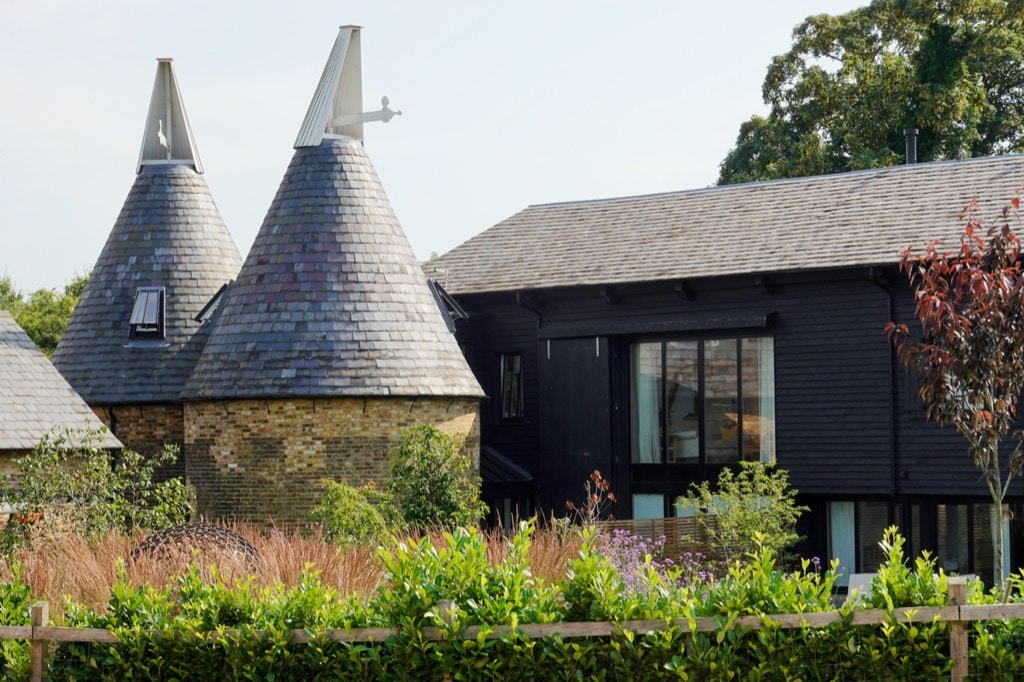

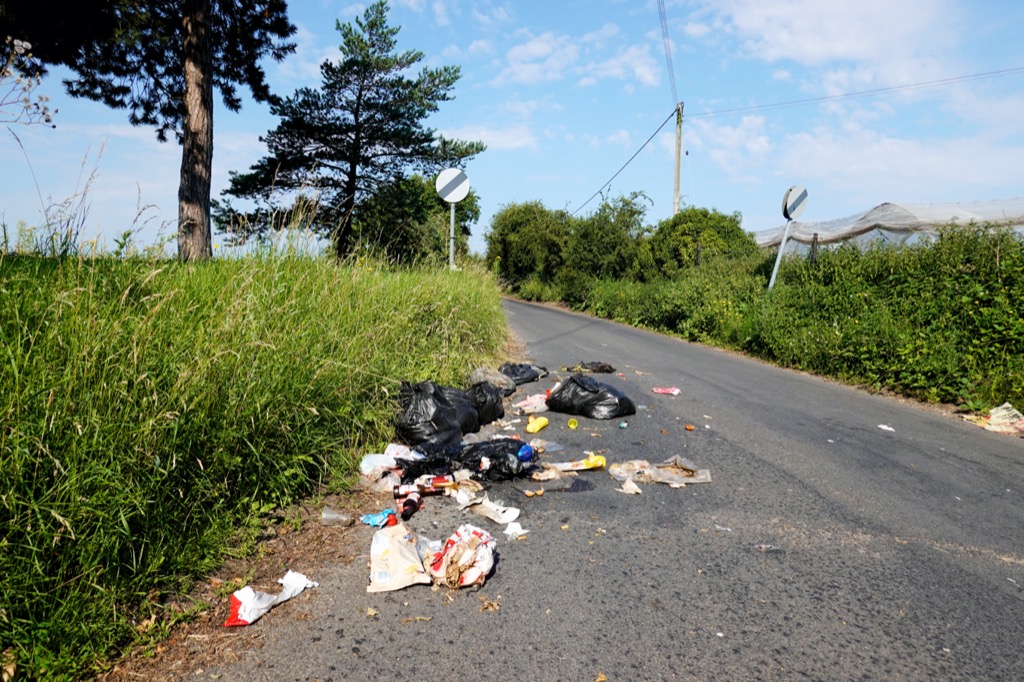


It’s quite shameful what goes on between the farmers and the supermarkets. The supermarkets have so much power. We’ve been growing more and more of our own fruit and veg and it’s so rewarding. I wish I had a space for a poly tunnel!